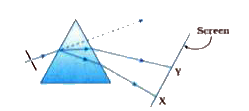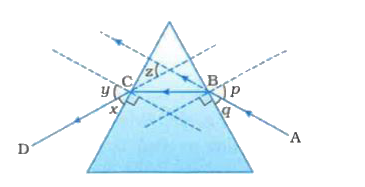Complete Solutions to OBJECTIVE QUESTIONS AND ANSWERS (Answer the following questions in very short as directed (Miscellaneous) ) of chapter THE HUMAN EYE AND THE COLOURFUL WORLD of Class 10 book with complete answers and questions
| Class 10 | PHYSICS |
| Chapter | THE HUMAN EYE AND THE COLOURFUL WORLD |
| KUMAR PRAKASHAN | OBJECTIVE QUESTIONS AND ANSWERS (Answer the following questions in very short as directed (Miscellaneous) ) |
| Number Of Questions | 55 |
| Academic Year | 2023-24 |
What is the power of a lens that can be used to correct the eye defect of a person who cannot see the objects distinctly kept beyond 2 m ?
01:36View SolutionWhy does the Sun appear white at noon ?
00:43View SolutionWhy is the eye lens not perfectly solid ?
01:45View SolutionWhat is the focal length of plain goggles ?
00:41View SolutionWhat happens when elasticity of the crystalline lens is reduced to zero ?
00:55View SolutionWhich defect of the eye occurs due to distortion of cornea ?
00:52View SolutionHow the defect of astigmatism can be corrected ?
01:54View SolutionWhat is colour blindness? How can it be cured?
01:25View SolutionIn hypermetropia, how does the size of eyeball change ?
00:43View SolutionWhat change occurs in the focal length, when our eye lens becomes thick ?
00:54View SolutionWhat are rods and cones ?
01:52View SolutionWhat is cataract ?
01:55View SolutionWhat would have been the colour of the sky, had there been no atmosphere ?
00:50View SolutionDue to which phenomenon is the colour of water in deep sea blue ?
02:18View SolutionWhat is the cause for presbyopia ?
01:10View SolutionGive the relationship between wavelength of light and its angle of deviation, when it is passed through a prism.
00:46View SolutionFor which colour has the glass larger refractive index – violet or green ?
00:53View SolutionWhich part of human eye is also known as 'white of the eye' ?
01:43View SolutionWhy is blind spot so called ?
01:39View SolutionWhich liquid is filled in the space between the eye lens and the retina ?
01:02View SolutionWhat happens to the pupil of the eye when the light is (a) very bright and (b) very dim?
01:24View SolutionA man is wearing spectacles of focal length +1 m. What can be the defect in the eye ?
00:44View SolutionWhich portion of a bi-focal lens is
(a) a concave lens
(b)a convex lens ?00:46View SolutionWhen sunlight enters into a room filled with dark smoke, its path becomes visible. Name the phenomenon responsible for this.
01:05View SolutionWhat is the function of the iris ?
01:09View SolutionWhat are light sensitive cells ?
01:23View SolutionWhat type of signals are generated and sent to the brain by light sensitive cells in the retina ?
01:44View SolutionWhat holds the crystalline lens in the human eye?
00:52View SolutionWhich part of the human eye helps in changing the thickness of the eye lens ?
00:56View SolutionWhat is dispersion of white light ?
01:27View SolutionGive the main difference between the lens of the human eye and the lens of a camera.
01:50View SolutionThe image formed on the retina is inverted, but we see the object erect. Why?
02:16View SolutionThe absolute refractive index of a medium is 2.0. The speed of light in vacuum/air is `3 xx 10^(8) m s^(-1)`. Find the speed of light in the medium.
01:35View SolutionMatch the column properly:
 01:06View Solution
01:06View SolutionMatch the following column:
 01:56View Solution
01:56View SolutionThe far point of a myopic eye is 100 cm. What is the focal length of the lens required to see very distant (normal far point) objects clearly?
02:04View SolutionThe near point of a hypermetropic eye is 75 cm. What is the focal length of the lens required to see clearly an object placed at 25 cm from the eye (normal near point)?
02:25View SolutionThe eye lens of human eye is a double convex lens. Agree or Disagree?
01:35View SolutionCone-shaped retinal cells respond to the brightness or intensity of light. Agree or Disagree?
01:02View SolutionWhich property of vision is used in cinematography ?
00:58View SolutionWhat is aqueous humour ?
01:05View SolutionWhat is the maximum power of accommodation of a normal eye ?
01:23View SolutionWhat is meant by scattering of light?
01:59View SolutionWhat is the basic cause of atmospheric refraction ?
01:35View Solution
In the above figure a narrow beam of white light is shown to pass through a triangular glass prism. After passing through the prism, it produces a spectrum XY on a screen. State the colour seen at (i) X and (ii) Y.01:36View Solution
In the above figure, which angles are correctly marked ?01:39View Solution
In the above figure (ray diagram), state the angle of incidence and the angle of deviation.02:40View Solution
In the above figure (ray diagram), state angle of incidence, angle of emergence and angle of deviation.01:46View SolutionWhat is the principle of the working of the human eye?
01:28View SolutionOn which factor does the colour of the scattered white light depend ?
01:06View SolutionGive the scientific names of the following parts of the eye :
(a) Carrying signals from an eye to the brain.
(b) A small opening (hole) in the middle of the iris.01:38View SolutionA near-sighted person has a near point 25 cm and a far point 50 cm. Can he see clearly an object at a distance of: (i) 5 cm, (ii) 25 cm, (iii) 60 cm. Write 'Yes' or 'No' only.
02:52View SolutionThe near point of a far-sighted person is 50 cm.
Can the person see clearly an object at a distance of: (i) 20 cm ( ii ) `oo` (infinity)02:25View SolutionHow much is our horizontal field of view
(a) with one eye open
(b) with both eyes open ?01:14View SolutionWhich of the following have a wider field of view ?
(a) Animals having two eyes on the opposite sides of their head or (b) Animals having two eyes at the front of their head.02:22View Solution
OBJECTIVE QUESTIONS AND ANSWERS (Answer the following questions in very short as directed (Miscellaneous) ) questions and complete solutions for chapter THE HUMAN EYE AND THE COLOURFUL WORLD of KUMAR PRAKASHAN of Class 10
All Exercises from KUMAR PRAKASHAN Class 10 PHYSICS THE HUMAN EYE AND THE COLOURFUL WORLD
- ADDITIONAL QUESTIONS AND ANSWERS
- OBJECTIVE QUESTIONS AND ANSWERS
- OBJECTIVE QUESTIONS AND ANSWERS (Answer the following questions in very short as directed (Miscellaneous) )
- OBJECTIVE QUESTIONS AND ANSWERS (Choose the correct option)
- OBJECTIVE QUESTIONS AND ANSWERS(Answer the following questions in one word / sentence)
- OBJECTIVE QUESTIONS AND ANSWERS(Fill in the blanks)
- OBJECTIVE QUESTIONS AND ANSWERS(State whether the following statements are true or false)
- Practical Skill Based Questions with Answers
- QUESTIONS AND ANSWERS
- TEXTUAL EXERCISE
- Value Based Questions With Answers
